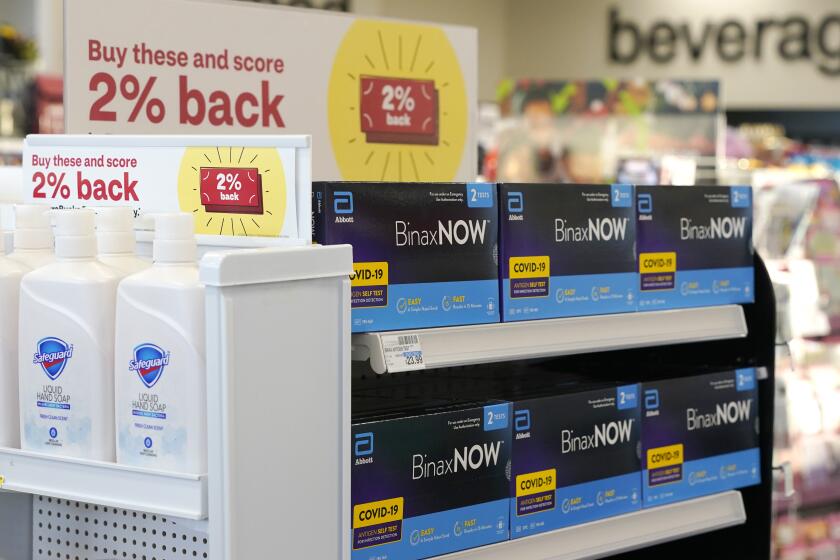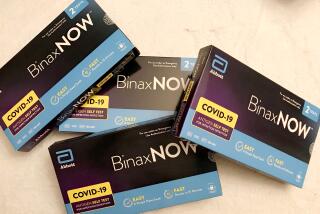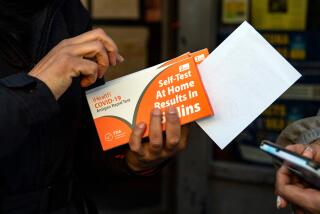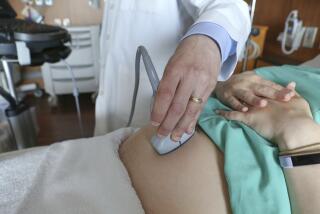Why are rapid tests for COVID-19 in such short supply?
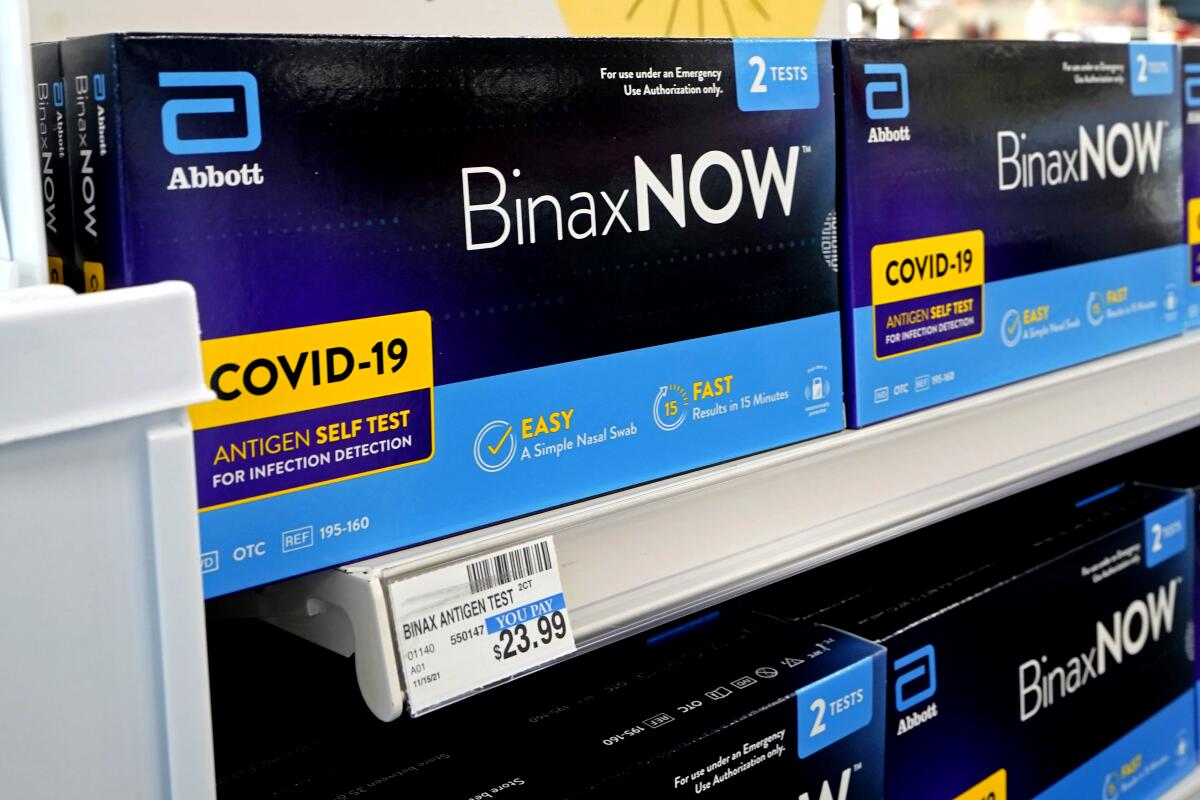
- Share via
Is that tickle in your nose COVID-19, or just a cold? Answering that question has proven to be difficult as Americans struggle to access coronavirus testing around the country.
At-home rapid antigen tests are reselling for triple the retail price on some digital marketplaces. Testing locations in L.A. County have been overwhelmed by mile-long lines, with some events canceled due to traffic. Some would-be self-testers have resigned themselves to driving between CVS and Walgreens locations, hoping to snag a kit at a reasonable price.
Companies are racing to fulfill the excess demand.
Abbott Laboratories, which makes the BinaxNOW rapid antigen test, expects to produce 70 million tests this month and is working to raise that to 100 million, said CEO Robert Ford.
In February, San Diego-based Quidel opened a manufacturing plant in Carlsbad with the capacity to produce 600 million tests a year.
Given that the U.S. has been experiencing COVID waves for nearly two years, you may be wondering: How did we find ourselves in this situation? The Times spoke with public health experts to understand the roots of the shortfall and what might be done to avoid one next time.
Who’s making at-home rapid antigen tests?
For the record:
2:43 p.m. Jan. 10, 2022An earlier version of this article incorrectly said the Centers for Disease Control had authorized at least 12 rapid antigen at-home antigen tests. The Food and Drug Administration is responsible for authorizing medical tests.
The Food and Drug Administration has authorized at least 12 rapid antigen tests that can be conducted at home without requiring a prescription. Half were approved between October and December.
The earliest approved were tests produced by Abbott Laboratories and Quidel Corp., which received their emergency use authorizations from the Food and Drug Administration in March 2021.
Abbott’s tests alone account for about 75% of U.S. retail sales, according to an October earnings call. For the third quarter of 2021, Abbott reported a year-over-year revenue gain of 23.4%, largely on the strength of $1.9 billion in global test sales. Coronavirus tests accounted for $510 million of Quidel’s roughly $635 million of revenue in the fourth quarter.
So why aren’t they making enough tests?
Bob Kocher, who co-led California’s COVID-19 testing task force, said the rapid test shortage ultimately came down to a failure to anticipate demand.
“If you’re a test manufacturer, you’ve been reluctant to make tests that you’re not sure you’re going to sell,” said Kocher, a physician and venture capitalist who served in the Obama administration as special assistant to the president for healthcare and economic policy. “And if you go back a few months, before we had Omicron, and even Delta, there was a sense that OK, we have low numbers of cases in America, we’re vaccinating people, and COVID might go away.”
During that time, Abbott shut down two production lines and closed a manufacturing plant. The shelf life for most rapid antigen tests ranges from a few months to a year.
“The question is, is the government or somebody willing to pay for them and take the risk that you don’t use them? Because the manufacturers don’t want to do that,” Kocher said.
Why does demand for at-home tests seem so much higher than it was in previous surges?
Perhaps because during previous waves, the focus was on social distancing, masking and, ultimately, vaccination as the keys to blocking virus transmission.
“We all hoped at a certain point earlier in [2021], maybe just about a year ago, that vaccination was going to be the answer,” said Mara Aspinall, a healthcare industry leader and professor at Arizona State University College of Health Solutions.
Officials warn of price gouging as online marketplaces sell two-test packages for $75 or $80.
In the past year, vaccines have proven highly effective in preventing hospitalization and death from COVID-19 — but the coronavirus has shown it can evolve to be highly transmissible even in the vaccinated and cautious. With the Omicron and Delta variants driving new infections, the transmission rate in Los Angeles County is now estimated to be greater than at any point since the early months of the pandemic.
“So when you think about testing, why are we testing? We’re not just testing to count the number of people, we’re testing to slow the spread of disease,” Aspinall said.
Is government red tape a factor in the shortage?
Many have pointed fingers at the FDA for its slow approval of rapid antigen tests early on in the pandemic.
In March, consulting firm Booz Allen Hamilton conducted an independent review of the emergency use authorization process, which allows the agency to approve medical devices and treatments quickly in a public health emergency.
The firm found that the median number of days it took for the agency to issue a decision rose from 29 in April 2019 to 99 in November 2020. Denials took up to 186 days for applications submitted in April 2020.
The director of the FDA office that authorizes tests, Tim Stenzel, told ProPublica the office received many applications that were either incomplete or had bad data, and any delays were due to careful review.
Kocher said the tests being submitted early on simply didn’t work well enough.
The FDA was receiving a lot of “bad tests,” he said.
But Michael Mina, epidemiologist and chief science officer at digital healthcare company eMed, said the FDA set unrealistic standards for rapid antigen tests that were incongruent with the purpose of frequent, rapid testing.
The FDA has asked companies to demonstrate that their rapid antigen tests are nearly as sensitive as PCR tests, which can return a positive test for more than a month after infection by detecting the presence of any amount of the virus’ genetic material.
But antigen tests — which look for the presence of proteins on the surface of the virus — are specific to when someone is infectious, and should only be positive when the person has a high viral load in their nose and throat, which sometimes only lasts around six days, Mina said.
“The reality is, [the FDA is] asking for a mathematical impossibility unless the company intentionally skews the participants in their trial and very carefully kind of curates or cherry-picks what participants are going to join their clinical trial,” Mina said.
This process is expensive and ultimately provides no useful data to the agency, Mina said. It also doesn’t make sense, given what most Americans are using rapid testing for.
“They’re using them to keep the people around them safe, to ask the question — am I infectious right now? Am I a risk to my grandma, am I a risk to my neighbors?” Mina said.
Is there anything the government can do about it now?
In December, the Biden administration announced a plan to purchase 500 million at-home test kits and mail them for free to Americans who want them starting this month.
Public health officials say the move comes too late, with the Omicron surge already well underway.
“All of these are reactive and not proactive,” said Aditi Nerurkar, a physician at Harvard Medical School. “It is a wonderful idea to have a website and a central clearinghouse for people to obtain tests, but that should have happened in October and not in January.”
In L.A. County, a free test-by-mail PCR testing program that could offer results within about four days was suspended Wednesday “due to the current backlog in the logistics of processing kits,” county officials said.
Aspinall called the next three months “essential” for rapid testing as the surge coincides with the return of the traditional flu season that was largely nonexistent last year due to social distancing and masking measures.
Are other countries having the same problem?
It’s not just the U.S. — demand for rapid antigen tests is skyrocketing around the world. Obtaining the tests is getting increasingly difficult in countries across Europe, leading to stores limiting the number of tests each customer can buy.
The shortage is partially mitigated by the number of test manufacturers, however; at least 36 self-administered rapid antigen tests are approved for use under standards set by the European Union, according to an Arizona State University database.
Tests are also cheaper and more easily accessible in some European countries, aided by preexisting robust public health systems. In the U.K. and Germany, the government has been purchasing hundreds of millions of home testing kits to distribute freely to its citizens for months, though Germany ended its program in October to focus on getting people vaccinated.
“In a pandemic, having that system … has helped with lowering the cost of distribution and making the process easier,” Aspinall said, compared to the obstacles the U.S. federal government faces in distributing the 500 million free tests.
More to Read
Inside the business of entertainment
The Wide Shot brings you news, analysis and insights on everything from streaming wars to production — and what it all means for the future.
You may occasionally receive promotional content from the Los Angeles Times.
